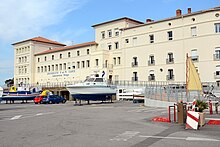Observatoire océanologique de Banyuls-sur-Mer
The Observatoire océanologique de Banyuls-sur-Mer - formerly Laboratoire de Banyuls-sur-Mer or Laboratoire de biologie marine de Banyuls-sur-Mer - is a French research station in Banyuls-sur-Mer in the Pyrénées-Orientales department in the Languedoc Roussillon .
Historical
The first marine stations were built in the second half of the 19th century. The intention was to have scientists study marine organisms on site in the vicinity of their natural habitat and not have to transport them to laboratories further away. In the early 1880s and after the establishment of the marine station Roscoff ( Station biologique de Roscoff ) on the English Channel by the zoologist Félix Joseph Henri de Lacaze-Duthiers (1821-1901) of the Sorbonne, it was decided to build a second one on the Mediterranean coast To establish station.
This rocky coastal region of Languedoc-Roussillon Rosselló is historically a comarca of northern Catalonia . It offered and provides habitat ( biodiversity ) to a large number of organisms , so that the scientist Lacaze-Duthiers decided to build another laboratory in Banyuls-sur-Mer (in Catalan Banyuls de la Marenda). Construction of the laboratory began in 1881. In 1882 the laboratoire opened its doors with research stations, offices, a library and a boat. The public aquarium was opened around 1884 to 1885 and the first students soon joined.
Since its inception, it has been one of the main tasks of the laboratory and of future generations of scientists to research the underwater world step by step and to involve the public in it. The laboratory also plays host to scientists worldwide. In the early 1890s, the laboratory's prestige drew the attention of Prince Roland Bonaparte (1858–1924) (botanist, geographer, and philanthropist).
Current
Today the Laboratoire de biologie marine de Banyuls-sur-Mer is officially called Observatoire océanologique de Banyuls sur mer , often also referred to as Laboratoire Arago , and is part of the Université Pierre et Marie Curie (UPMC), the L'Institut national des sciences de l 'Univers (INSU) and the Le Center national de la recherche scientifique (CNRS) and space for researchers and students. There are essentially four complexes:
- Laboratoire d'Océanographie Microbienne (oceanological microbiology)
- Laboratoire d'Ecogéochimie des Environnements Benthiques; (Eco-geochemistry of benthic habitats)
- Biology Integrative des Organism Marins; (Ecology of Marine Systems)
- Biocomplexité des Ecosystèmes Coraliens de l'Indo-Pacifiques; (Complexity of the coral reefs of the Indo-Pacific)
- l'Observatoire océanologique de Banyuls (Oceanology of Banyuls)
In June 2010 the Jardin mediterraneen du mas de la serre was opened, a commercially operated approx. 3 hectare nature park on the site of the former Arago research laboratory. The biodiversarium offers space for communication about biological diversity and comprises two aspects with the garden and the public aquarium with a laboratory. The current postal address is " Laboratoire Arago, 66650 Banyuls-sur-Mer, France ".
Web links
- Website of the Observatoire océanologique de Banyuls-sur-Mer
- View from the years 1882, 1883–1891 [1]
Individual evidence
- ↑ http://www.obs-banyuls.fr/fr/l_observatoire_oceanologique/historique.html
- ↑ Archived copy ( Memento of the original from January 27, 2012 in the Internet Archive ) Info: The archive link was inserted automatically and has not yet been checked. Please check the original and archive link according to the instructions and then remove this notice.
- ↑ http://www.upmc.fr/content/default/observatoire_oceanologique_de_banyuls_sur_mer/fr/data/8411837594224605600.gif
- ↑ http://www.insu.cnrs.fr/
- ↑ http://www.cnrs.fr/
Coordinates: 42 ° 28 ′ 49.5 " N , 3 ° 8 ′ 12.2" E
